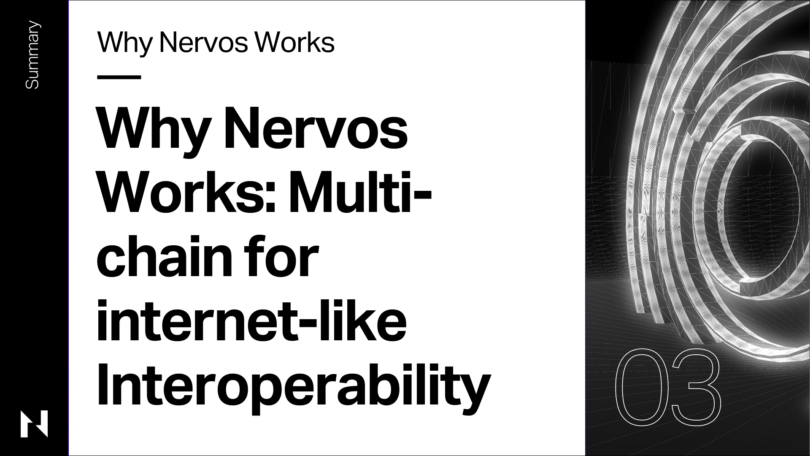For the past few weeks, we have broken down ‘Why Nervos Works’. Starting with the Layer 1 Common Knowledge Foundation, for security and decentralization, and moving to the Layer 2 of our architecture, which offers flexibility and future-proofing – we now turn to interoperability.
Interoperability has always been a particular target for Nervos. We noted how early internet applications lived on segregated networks needing different ways to access and interact, and now, in today’s decentralized world, we again see this segregation into different ecosystems with poor interoperability.
The Nervos Network solves this problem by offering a layered architecture that leads inherently to a powerful multi-chain approach.
A foundation for Multi-Chain Capabilities
At the foundation of the ecosystem is the layer 1 CKB blockchain. It is designed to maximize security and decentralization. It provides trust and validation to all layers built on top of it.
Layer 2 is designed to maximize scalability and throughput with near-instant transaction finality. Multiple Layer 2s can be used in parallel to give higher throughput and bring additional features to the ecosystem.
Structurally, the Nervos virtual machine uses a computer architecture that gives blockchain developers a level of flexibility and power that cannot be found on any other platform. This makes it easy for Nervos to quickly adapt to rapid changes in the industry, ongoing limitations, or respond to future challenges.
Having this structured architecture and utilizing different tools, Nervos becomes a platform designed to be inherently multi-chain.
Because of the construction of the Layer 1 CKB, Nervos operates at the lowest foundational level, by emulating hardware itself on its virtual machine. This enables it to adapt quickly to future changes in the industry because the developer is given the flexibility of a full computer in a blockchain environment.
Adopting new cryptography – as in the fundamentals of another chain – is a massive undertaking that requires a hard fork on many other platforms. On Nervos, it’s as simple as importing a new library into your smart contract.
Nervos’ vision of interoperability does not require that other projects be forced to conform to a single protocol. This is an unrealistic expectation for an industry where innovation occurs rapidly, and competing protocols are always changing.
Not all interoperability solutions are created equal, and many stop at a superficial level. Nervos excels in this regard, by demonstrating that it has the ability to adapt itself to the protocols of other platforms.
Force Bridge and More
The process starts with Force Bridge, a cross-chain bridge that allows assets like tokens and NFTs to move freely back and forth between Nervos and other networks. At the same time, bridges are nothing new, Nervos’ ability to adapt means that it can support multiple address formats from other blockchains directly on the Nervos blockchain.
This means that users can use their existing dApp wallets with dApps built on Nervos even though the wallet was never designed to support Nervos. This means there is nothing new to install and nothing new to learn; everything just works seamlessly – a true multi-chain, internet-like experience.
Nervos’ goal is to eventually provide bridges to all of the major blockchains, giving developers access to the largest reach possible. Developers get massive efficiency savings because, on Nervos, all users will be able to use their dApp without having to create a separate version for every individual chain.
Through the capability enabled by Nervos, developers no longer need to create dApps that can require extensive resources to build on other blockchains. Eventually, all dApps on Nervos will be connected to many blockchains, thereby making the dApp an instant universal dApp.
As it stands, Ethereum is the biggest and most popular programmable blockchain – however, it has limitations and flaws. Additionally, while well documented for developers on how to build, the ecosystem is saturated and siloed.
Nervos solves this with its Layer 2; the first Layer 2 is designed for scalability and Ethereum compatibility. It is fully compatible with the Ethereum programming environment – EVM – which means that existing dApps written in the Solidity programming language can port to Nervos with no smart contract changes necessary. Ethereum developers will feel right at home building on Nervos.
This is the third part of a four-part series that breaks down the architecture of Nervos and why it works as a blockchain platform for today, and into the future. Stay tuned for our final article on Blockchain Abstraction
To stay updated on all things Nervos:
Join our community: Discord — Github — Nervos Talk Forum — Twitter
For discussions or questions join the conversation on Discord or check out one of our community Telegram channels: English, Korean, Russian, Japanese, Spanish, Vietnamese and Chinese
